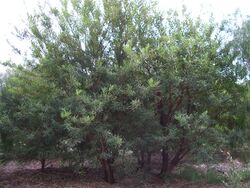Biology:Callistachys lanceolata
| Callistachys lanceolata | |
|---|---|

| |
| Scientific classification | |
| Kingdom: | Plantae |
| Clade: | Tracheophytes |
| Clade: | Angiosperms |
| Clade: | Eudicots |
| Clade: | Rosids |
| Order: | Fabales |
| Family: | Fabaceae |
| Subfamily: | Faboideae |
| Genus: | Callistachys |
| Species: | C. lanceolata
|
| Binomial name | |
| Callistachys lanceolata Vent.
| |
Callistachys lanceolata, commonly known as the wonnich or native willow, is a species of tree that is native to the South West of Australia . C. lanceolota has the synonym Oxylobium lanceolatum.[1]
Description
An erect evergreen tree or shrub with a height of 1.5 metres (5 ft) to 7 metres (23 ft).[2] The plant has conspicuous and attractive inflorescence composed of racemes with yellow flowers. The plant flowers through the spring time between the months of September to January.[3] The leaves of the plant are leathery and are arranged in whorls, most typically with three leaves per whorl. The leaves are generally regular in shape between 40 millimetres (2 in) to 170 millimetres (7 in) in length and 4 millimetres (0 in) to 30 millimetres (1 in) in width and have pointed tips.[4]
Distribution and habitat
Callistachys lanceolata occurs in the South West corner and South Coast of Western Australia. It grows well in sandy soils in areas that are damp, particularly along watercourses, swamps and culverts.[2]
Taxonomy
The species was first formally described by the botanist Étienne Pierre Ventenat in 1805 work Jardin de la Malmaison.[5] Several synonyms exist for the species, including Chorozema callistachys as described by Ferdinand von Mueller in 1863 in Fragmenta Phytographiae Australiae; Oxylobium callistachys by George Bentham in 1864 in Flora Australiensis and Oxylobium lanceolatum by Karel Domin in 1923 in New Additions to the Flora of Western Australia.
Cultivation
Seeds can be collected from the plant but the pods the seeds are found in should be left to dry on the plant before they are broken open. The seeds should be scarified before sowing.[6]
References
- ↑ "ILDIS - Callistachys lanceolata Vent.". 2008. Archived from the original on November 30, 2004. https://web.archive.org/web/20041130063316/http://www.ildis.org/LegumeWeb/6.00/taxa/16164.shtml. Retrieved 3 April 2008.
- ↑ 2.0 2.1 "Florabase - Callistachys lanceolata Vent.". 2008. http://florabase.calm.wa.gov.au/browse/profile/10861. Retrieved 5 April 2008.
- ↑ "Australian National University - School of Botany and Zoology". 2008. http://www.anu.edu.au/BoZo/Crisp/Mirbelieae/Callistachys.html. Retrieved 5 April 2008.
- ↑ "WRC/CALM - Native Vegetation of Freshwater Rivers and Creeks in south Western Australia". 1997. http://portal.water.wa.gov.au/portal/page/portal/WaterQuality/Publications/RiparianPlantsFieldGuide/Content/Native%20vegetation%20of%20freshwater.pdf. Retrieved 5 April 2008.
- ↑ "Callistachys lanceolata Vent.". Atlas of Living Australia. Global Biodiversity Information Facility. http://bie.ala.org.au/species/http://id.biodiversity.org.au/node/apni/2893819#names. Retrieved 4 January 2017.
- ↑ "Dave's Garden - PlantFiles Callistachys lanceolata". 2008. http://davesgarden.com/guides/pf/go/116572/. Retrieved 17 April 2008.
Wikidata ☰ Q5022770 entry

